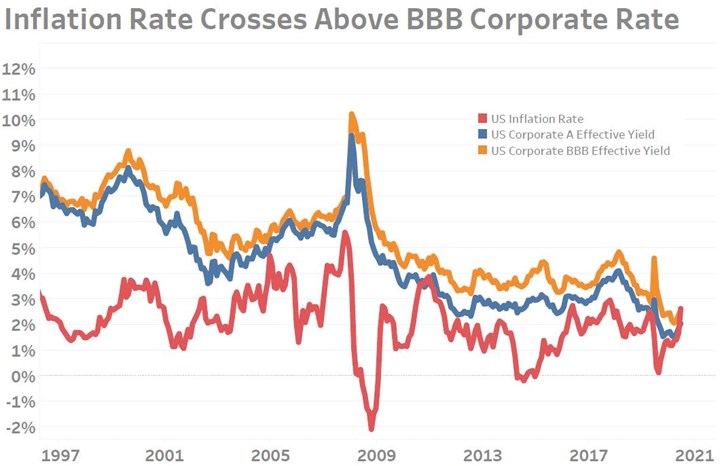Inflation Rate Exceeds Corporate Borrowing Costs
That the cost of goods and services (inflation) is rising faster than the cost of borrowing money suggests that the economy has come to an incredible rate intersection. This is particularly true in the “goods” space where inflation is at 5.4% according to the Bureau of Economic Analysis.
That the rate of inflation could be below the cost to borrow money defies a core principle of finance which is that borrowing costs should be the sum of 1.) the risk-free* rate of return plus 2.) a risk-premium. In general, the risk-free rate is the sum of the rate of inflation plus the yield of the treasury bond matching your investment duration. If we assume a 1-year rate of 0.05% as of late-April and an inflation rate of 2.62%, then the risk-free rate should be at least 2.67% (or higher if using a longer-dated treasury bond) before adding a risk premium. Other measures of inflation are much higher. The inflation rate of physical goods at last reporting by the Bureau of Economic Analysis stood at 5.4%. Using this formula over the last 20-years results in a risk premium of 1.5% – 3% for a BBB-rated bond yield. Meaning that a company only slightly above “junk” bond status requires a 1.5% to 3% premium to borrow money.
In the present situation, which has largely come about by the government’s unprecedented intervention in financial markets, the system has somehow found a way to defy longstanding financial logic. Using the same mathematical equation as before, the risk-free rate at present is at least 2.67% per data provided by Bank of America Merrill Lynch. However, the yield of BBB-rated companies is 2.43%. This clearly presents a problem given that a company only one-notch above junk status — and thus relatively risky— should not be able to borrow money BELOW the risk-free rate capital. Data provided by Moody’s Analytics in the form of their Baa Corporate Bond Rate was last reported at 3.60%, providing a risk-premium of less than 1% when using the lowest possible calculation of the risk-free rate.

Inflation exceeded the BBB-rated corporate bond rate for the first time since at least 1997. This intersect implies that borrowing is extremely cheap.
What Is One To Do?
The data suggest that the economy is headed toward a precarious financial position. When borrowing costs are well below their appropriate level, it means that a lot of investments (many of which will fail as they always do) are going to be funded in the near-term. In theory, one could borrow money, buy a physical good whose values move only with the rate of inflation — but do nothing with it otherwise — and then later sell it for a profit thanks to the spread in inflation and credit rates.
When a growing proportion of these investments begin to go bust, banks will have to strengthen their lending standards and the interest rate they charge on loans will have to be adjusted to match the actual risk of the investments being funded. As such, Gardner will be carefully watching corporate default data and bank stress measures. If either of these begin to flash warning signs, it is likely that the economic boom created by incredibly cheap borrowing costs is nearing its end.
*The risk-free rate represents the interest an investor would expect from an absolutely risk-free investment over a specified period of time. The real risk-free rate can be determined by subtracting the current inflation rate from the yield of the Treasury bond that is equivalent in duration to the length of the time the money will be borrowed.




.jpg;width=70;height=70;mode=crop)
